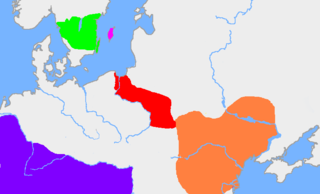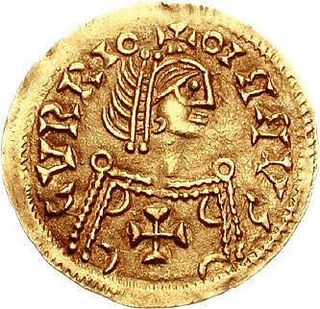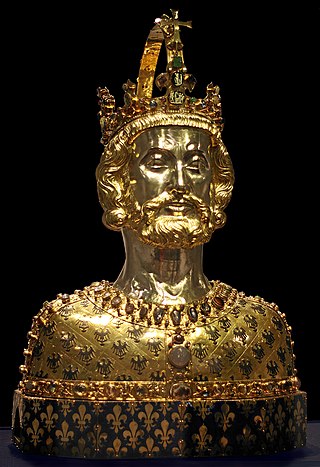Sippe is German for "clan, kindred, extended family" (Frisian Sibbe, Norse Sifjar).
It continues a Proto-Germanic term *sebjō, which referred to a band or confederation bound by a treaty or oath, not primarily restricted to blood relations. [1] The original character of sippe as a peace treaty is visible in Old English, e.g. in Beowulf (v. 1858):
- hafast þû gefêred, þæt þâm folcum sceal,
- Geáta leódum ond Gâr-Denum
- sib gemæne ond sacu restan.
The Sippe came to be a cognatic, [2] extended family unit, exactly analogous to the Scottish/Irish sept. [3]
Most of the information left about the nature and role of the Sippe is found in records left by the Lombards, Alamanni, and Bavarians. [4] One of the functions of the Sippe was regulating use of forests. The average Sippe likely contained no more than 50 families. [5] The Sippe seems to have been absorbed into the monogamous family later on; P.D. King asserts that this was already the case among the Visigoths during the time of the Visigothic Kingdom. [6]

The Burgundians were an early Germanic tribe or group of tribes. They appeared in the middle Rhine region, near the Roman Empire, and were later moved into the empire, in eastern Gaul. They were possibly mentioned much earlier in the time of the Roman Empire as living in part of the region of Germania that is now part of Poland.

Scandinavia is a subregion of Northern Europe, with strong historical, cultural, and linguistic ties between its constituent peoples. Scandinavia most commonly refers to Denmark, Norway, and Sweden. It can sometimes also refer to the Scandinavian Peninsula. In English usage, Scandinavia is sometimes used as a synonym for Nordic countries. Iceland and the Faroe Islands are sometimes included in Scandinavia for their ethnolinguistic relations with Sweden, Norway and Denmark. While Finland differs from other Nordic countries in this respect, some authors call it Scandinavian due to its economic and cultural similarities.

Theodoricthe Great, also called Theodoric the Amal, was king of the Ostrogoths (475–526), and ruler of the independent Ostrogothic Kingdom of Italy between 493 and 526, regent of the Visigoths (511–526), and a patrician of the Eastern Roman Empire. As ruler of the combined Gothic realms, Theodoric controlled an empire stretching from the Atlantic Ocean to the Adriatic Sea. Though Theodoric himself only used the title 'king' (rex), some scholars characterize him as a Western Roman Emperor in all but name, since he ruled a large part of the former Western Roman Empire described as a Res Publica, had received the former Western imperial regalia from Constantinople in 497 which he used, was referred to by the imperial title princeps by the Italian aristocracy and exercised imperial powers recognized in the East, such as naming consuls.

The Visigoths were a Germanic people united under the rule of a king and living within the Roman Empire during late antiquity. The Visigoths first appeared in the Balkans, as a Roman-allied barbarian military group united under the command of Alaric I. Their exact origins are believed to have been diverse but they probably included many descendants of the Thervingi who had moved into the Roman Empire beginning in 376 and had played a major role in defeating the Romans at the Battle of Adrianople in 378. Relations between the Romans and Alaric's Visigoths varied, with the two groups making treaties when convenient, and warring with one another when not. Under Alaric, the Visigoths invaded Italy and sacked Rome in August 410.

A thing, also known as a folkmoot, assembly, tribal council, and by other names, was a governing assembly in early Germanic society, made up of the free people of the community presided over by a lawspeaker. Things took place at regular intervals, usually at prominent places that were accessible by travel. They provided legislative functions, as well as being social events and opportunities for trade. In modern usage, the meaning of this word in English and other languages has shifted to mean not just an assemblage of some sort but simply an object of any sort.

Ermanaric was a Greuthungian Gothic king who before the Hunnic invasion evidently ruled a sizable portion of Oium, the part of Scythia inhabited by the Goths at the time. He is mentioned in two Roman sources: the contemporary writings of Ammianus Marcellinus, and in Getica by the sixth-century historian Jordanes. He also appears in a fictionalized form in later Germanic heroic legends.

The Visigothic Code, also called Lex Visigothorum, is a set of laws first promulgated by king Chindasuinth of the Visigothic Kingdom in his second year of rule (642–643) that survives only in fragments. In 654 his son, king Recceswinth (649–672), published the enlarged law code, which was the first law code that applied equally to the conquering Goths and the general population, of which the majority had Roman roots, and had lived under Roman laws.
The Danes were a North Germanic tribe inhabiting southern Scandinavia, including the area now comprising Denmark proper, northern and eastern England, and the Scanian provinces of modern-day southern Sweden, during the Nordic Iron Age and the Viking Age. They founded what became the Kingdom of Denmark. The name of their realm is believed to mean "Danish March", viz. "the march of the Danes", in Old Norse, referring to their southern border zone between the Eider and Schlei rivers, known as the Danevirke.

East Francia or the Kingdom of the East Franks was a successor state of Charlemagne's empire ruled by the Carolingian dynasty until 911. It was created through the Treaty of Verdun (843) which divided the former empire into three kingdoms.

Liuvigild, Leuvigild, Leovigild, or Leovigildo, was a Visigothic King of Hispania and Septimania from 568 to 586. Known for his Codex Revisus or Code of Leovigild, a law allowing equal rights between the Visigothic and Hispano-Roman population, his kingdom covered modern Portugal and most of modern Spain down to Toledo. Liuvigild ranks among the greatest Visigothic kings of the Arian period.
The Amali – also called Amals, Amalings or Amalungs – were a leading dynasty of the Goths, a Germanic people who confronted the Roman Empire during the decline of the Western Roman Empire. They eventually became the royal house of the Ostrogoths and founded the Ostrogothic Kingdom.
Kingdom of Burgundy was a name given to various states located in Western Europe during the Middle Ages. The historical Burgundy correlates with the border area of France and Switzerland and includes the major modern cities of Geneva and Lyon.

The Kingdom of the Suebi, also called the Kingdom of Galicia or Suebi Kingdom of Galicia, was a Germanic post-Roman kingdom that was one of the first to separate from the Roman Empire. Based in the former Roman provinces of Gallaecia and northern Lusitania, the de facto kingdom was established by the Suebi about 409, and during the 6th century it became a formally declared kingdom identifying with Gallaecia. It maintained its independence until 585, when it was annexed by the Visigoths, and was turned into the sixth province of the Visigothic Kingdom in Hispania.

The Visigothic Kingdom, Visigothic Spain or Kingdom of the Goths occupied what is now southwestern France and the Iberian Peninsula from the 5th to the 8th centuries. One of the Germanic successor states to the Western Roman Empire, it was originally created by the settlement of the Visigoths under King Wallia in the province of Gallia Aquitania in southwest Gaul by the Roman government and then extended by conquest over all of Hispania. The Kingdom maintained independence from the Eastern Roman or Byzantine Empire, whose attempts to re-establish Roman authority in Hispania were only partially successful and short-lived.

Germanic law is a scholarly term used to describe a series of commonalities between the various law codes of the early Germanic peoples. These were compared with statements in Tacitus and Caesar as well as with high and late medieval law codes from Germany and Scandinavia. Until the 1950s, these commonalities were held to be the result of a distinct Germanic legal culture. Scholarship since then has questioned this premise and argued that many "Germanic" features instead derive from provincial Roman law. Although most scholars no longer hold that Germanic law was a distinct legal system, some still argue for the retention of the term and for the potential that some aspects of the Leges in particular derive from a Germanic culture. Scholarly consensus as of 2023 is that Germanic law is best understood in opposition to Roman law, in that it was not "learned" and incorporated regional pecularities.

North Germanic peoples, Nordic peoples and in a medieval context Norsemen, were a Germanic linguistic group originating from the Scandinavian Peninsula. They are identified by their cultural similarities, common ancestry and common use of the Proto-Norse language from around 200 AD, a language that around 800 AD became the Old Norse language, which in turn later became the North Germanic languages of today.

King is the title given to a male monarch in a variety of contexts. A king is an absolute monarch if he holds the powers of government without control, or the entire sovereignty over a nation; he is a limited monarch if his power is restrained by fixed laws; and he is an absolute, when he holds the whole legislative, judicial, and executive power, or when the legislative or judicial powers, or both, are vested in other people by the king. Kings are hereditary sovereigns when they hold the powers of government by right of birth or inheritance, and elective when raised to the throne by choice.
Surviving texts indicate that there was a belief in rebirth in Germanic paganism. Examples occur in eddic poetry and sagas, potentially associated with naming and/or through the family line. Scholars have discussed the implications of these attestations and proposed theories regarding belief in reincarnation among the Germanic peoples prior to Christianization and potentially to some extent in folk belief thereafter.

Early Germanic culture was the culture of the early Germanic peoples. Largely derived from a synthesis of Proto-Indo-European and indigenous Northern European elements, the Germanic culture started to exist in the Jastorf culture that developed out of the Nordic Bronze Age. It came under significant external influence during the Migration Period, particularly from ancient Rome.















